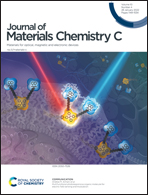A calcein-modified Zr(iv)-based metal–organic framework as a visualized sensor for calcium ions†
Abstract
Calcium ions (Ca2+) are one of the essential elements for biological growth, but the abnormal concentration of Ca2+ can also lead to various diseases. Therefore, it is of great significance to monitor the concentration of Ca2+ ions in the human body to be healthy. In this work, we develop a new fluorescent sensor towards Ca2+ ions by utilizing calcein to modify the stable Zr(IV)-based metal–organic framework, UiO-66-NH2. The original UiO-66-NH2 exhibits blue fluorescence at 425 nm under excitation at 344 nm, which is greatly weakened after the modification of calcein. The as-prepared UiO-66-NH2@calcein merely exhibits two extremely weak emissions centered at 414 and 517 nm with close peak intensity. These weak emissions can be enhanced when Ca2+ ions are introduced into the system. In particular, the peak intensity at 414 nm rapidly increases with the number of Ca2+ ions. The fluorescence enhancement efficiency displays a linear correlation with the concentration of Ca2+ ions in the range of 0–10 μM and the detection limit is as low as 0.6 μM. Moreover, the as-prepared UiO-66-NH2@calcein can be used as a probe for the monitoring of Ca2+ ions. A similar MOF-based fluorescent probe for the detection of Ca2+ ions has not been reported in previous studies.



 Please wait while we load your content...
Please wait while we load your content...